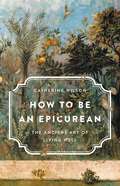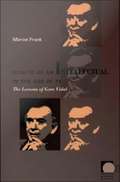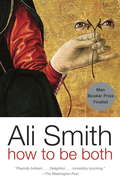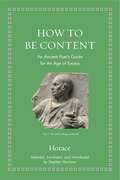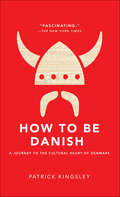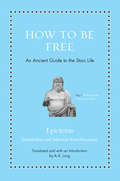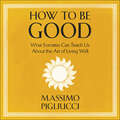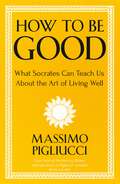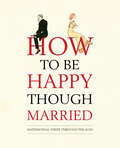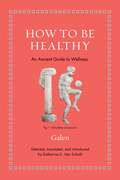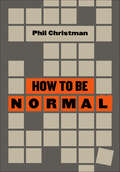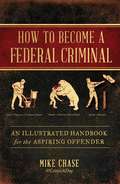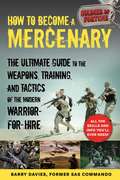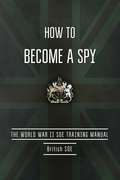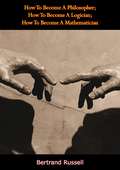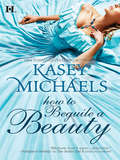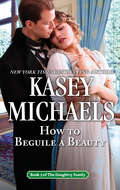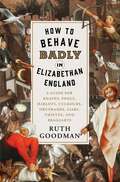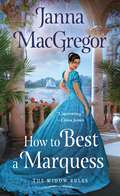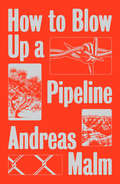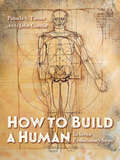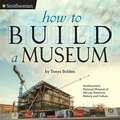- Table View
- List View
How to Be an Epicurean: The Ancient Art of Living Well
by Catherine WilsonA leading philosopher shows that if the pursuit of happiness is the question, Epicureanism is the answer Epicureanism has a reputation problem, bringing to mind gluttons with gout or an admonition to eat, drink, and be merry. In How to Be an Epicurean, philosopher Catherine Wilson shows that Epicureanism isn't an excuse for having a good time: it's a means to live a good life. Although modern conveniences and scientific progress have significantly improved our quality of life, many of the problems faced by ancient Greeks -- love, money, family, politics -- remain with us in new forms. To overcome these obstacles, the Epicureans adopted a philosophy that promoted reason, respect for the natural world, and reverence for our fellow humans. By applying this ancient wisdom to a range of modern problems, from self-care routines and romantic entanglements to issues of public policy and social justice, Wilson shows us how we can all fill our lives with purpose and pleasure.
How to Be an Intellectual in the Age of TV: The Lessons of Gore Vidal
by Marcie FrankNovelist, television personality, political candidate, and maverick social commentator, Gore Vidal is one of the most innovative, influential, and enduring American intellectuals of the past fifty years. In How to Be an Intellectual in the Age of TV, Marcie Frank provides a concise introduction to Vidal's life and work as she argues that the twentieth-century shift from print to electronic media, particularly TV and film, has not only loomed large in Vidal's thought but also structured his career. Looking at Vidal's prolific literary output, Frank shows how he has reflected explicitly on this subject at every turn: in essays on politics, his book on Hollywood and history, his reviews and interviews, and topical excursions within the novels. At the same time, she traces how he has repeatedly crossed the line supposedly separating print and electronic culture, perhaps with more success than any other American intellectual. He has written television serials and screenplays, appeared in movies, and regularly appeared on television, most famously in heated arguments with Norman Mailer on The Dick Cavett Show and with William F. Buckley during ABC's coverage of the 1968 Democratic National Convention. Frank highlights the connections between Vidal's attitudes toward TV, sex, and American politics as they have informed his literary and political writings and screen appearances. She deftly situates his public persona in relation to those of Andy Warhol, Jacqueline Susann, Mary McCarthy, Susan Sontag, and others. By describing Vidal's shrewd maneuvering between different media, Frank suggests that his career offers a model to aspiring public intellectuals and a refutation to those who argue that electronic media have eviscerated public discourse.
How to be both
by Ali SmithSHORT-LISTED FOR THE MAN BOOKER PRIZEPassionate, compassionate, vitally inventive and scrupulously playful, Ali Smith's novels are like nothing else. A true original, she is a one-of-a-kind literary sensation. Her novels consistently attract serious acclaim and discussion--and have won her a dedicated readership who are drawn again and again to the warmth, humanity and humor of her voice. How to be both is a novel all about art's versatility. Borrowing from painting's fresco technique to make an original literary double-take, it's a fast-moving genre-bending conversation between forms, times, truths and fictions. There's a Renaissance artist of the 1460s. There's the child of a child of the 1960s. Two tales of love and injustice twist into a singular yarn where time gets timeless, structural gets playful, knowing gets mysterious, fictional gets real--and all life's givens get given a second chance.A NOTE TO THE READER:Who says stories reach everybody in the same order? This novel can be read in two ways, and the eBook provides you with both. You can choose which way to read the novel by simply clicking on one of two icons--CAMERA or EYES. The text is exactly the same in both versions; the narratives are just in a different order. The ebook is produced this way so that readers can randomly have different experiences reading the same text. So, depending on which icon you select, the book will read: EYES, CAMERA, or CAMERA, EYES. (Your friend may be reading it the other way around.) Enjoy the adventure. (Having both versions in the same file is intentional.)
How to be both
by Ali Smith<P>Passionate, compassionate, vitally inventive and scrupulously playful, Ali Smith's novels are like nothing else. A true original, she is a one-of-a-kind literary sensation. Her novels consistently attract serious acclaim and discussion--and have won her a dedicated readership who are drawn again and again to the warmth, humanity and humor of her voice. <P>How to be both is a novel all about art's versatility. <P>Borrowing from painting's fresco technique to make an original literary double-take, it's a fast-moving genre-bending conversation between forms, times, truths and fictions. <P>There's a Renaissance artist of the 1460s. <P>There's the child of a child of the 1960s. <P>Two tales of love and injustice twist into a singular yarn where time gets timeless, structural gets playful, knowing gets mysterious, fictional gets real--and all life's givens get given a second chance. <P><b>Winner of the 2015 Women's Prize for Fiction <P>SHORT-LISTED FOR THE MAN BOOKER PRIZE</b>
How to Be Content: An Ancient Poet's Guide for an Age of Excess (Ancient Wisdom for Modern Readers)
by Horace Stephen HarrisonWhat the Roman poet Horace can teach us about how to live a life of contentment What are the secrets to a contented life? One of Rome’s greatest and most influential poets, Horace (65–8 BCE) has been cherished by readers for more than two thousand years not only for his wit, style, and reflections on Roman society, but also for his wisdom about how to live a good life—above all else, a life of contentment in a world of materialistic excess and personal pressures. In How to Be Content, Stephen Harrison, a leading authority on the poet, provides fresh, contemporary translations of poems from across Horace’s works that continue to offer important lessons about the good life, friendship, love, and death.Living during the reign of Rome’s first emperor, Horace drew on Greek and Roman philosophy, especially Stoicism and Epicureanism, to write poems that reflect on how to live a thoughtful and moderate life amid mindless overconsumption, how to achieve and maintain true love and friendship, and how to face disaster and death with patience and courage. From memorable counsel on the pointlessness of worrying about the future to valuable advice about living in the moment, these poems, by the man who famously advised us to carpe diem, or “harvest the day,” continue to provide brilliant meditations on perennial human problems.Featuring translations of, and commentary on, complete poems from Horace’s Odes, Satires, Epistles, and Epodes, accompanied by the original Latin, How to Be Content is both an ideal introduction to Horace and a compelling book of timeless wisdom.
How to Be Danish: A Journey to the Cultural Heart of Denmark
by Patrick KingsleyPart reportage, part travelogue, this is a fascinating introduction to contemporary Danish culture for anyone who wants to know more about the happiest nation in the world.Denmark is the country of the moment. The motherland of Borgen and The Killing, it&’s the runaway champion of Eurovision, and home to Noma, the world&’s most eccentric restaurant.But though we wear their sweaters and read their thrillers, how much do we really know about the Danes themselves? Part reportage, part travelogue, How to be Danish fills in the gaps – an introduction to contemporary Danish culture that spans politics, television, food, architecture and design. Welcome to the happiest country in the world.
How to Be Free: An Ancient Guide to the Stoic Life (Ancient Wisdom for Modern Readers)
by Epictetus Anthony LongA superb new edition of Epictetus’s famed handbook on Stoicism—translated by one of the world’s leading authorities on Stoic philosophyBorn a slave, the Roman Stoic philosopher Epictetus (c. 55–135 AD) taught that mental freedom is supreme, since it can liberate one anywhere, even in a prison. In How to Be Free, A. A. Long—one of the world’s leading authorities on Stoicism and a pioneer in its remarkable contemporary revival—provides a superb new edition of Epictetus’s celebrated guide to the Stoic philosophy of life (the Encheiridion) along with a selection of related reflections in his Discourses.Freedom, for Epictetus, is not a human right or a political prerogative but a psychological and ethical achievement, a gift that we alone can bestow on ourselves. We can all be free, but only if we learn to assign paramount value to what we can control (our motivations and reactions), treat what we cannot control with equanimity, and view our circumstances as opportunities to do well and be well, no matter what happens to us through misfortune or the actions of other people.How to Be Free features splendid new translations and the original Greek on facing pages, a compelling introduction that sets Epictetus in context and describes the importance of Stoic freedom today, and an invaluable glossary of key words and concepts. The result is an unmatched introduction to this powerful method of managing emotions and handling life’s situations, from the most ordinary to the most demanding.
How To Be Good: What Socrates Can Teach Us About the Art of Living Well
by Massimo PigliucciWhat Socrates's greatest failure says about a 2,000-year-old question: is it possible to teach ourselves and others to become better people? Can we make ourselves into better human beings? Can we help others do the same? And can we get the leaders of our society to care that humanity prospers, not just economically, but also spiritually? These questions have been asked for over two millennia and attempting to answer them is crucial if we want to live a better life and build a more just society. How to Be Good uses the story of Socrates and Alcibiades and examples from Aristotle, Marcus Aurelius and Machiavelli, alongside modern interpretations to explore what philosophy can teach us about the quest for virtue today. Whether we are statesmen or ordinary individuals Pigliucci argues that with a little work day by day we all have the power to pursue the timely and timeless art of living well.(P) 2022 Hachette Audio
How To Be Good: What Socrates Can Teach Us About the Art of Living Well
by Massimo PigliucciWhat Socrates's greatest failure says about a 2,000-year-old question: is it possible to teach ourselves and others to become better people? Can we make ourselves into better human beings? Can we help others do the same? And can we get the leaders of our society to care that humanity prospers, not just economically, but also spiritually? These questions have been asked for over two millennia and attempting to answer them is crucial if we want to live a better life and build a more just society. How to Be Good uses the story of Socrates and Alcibiades and examples from Aristotle, Marcus Aurelius and Machiavelli, alongside modern interpretations to explore what philosophy can teach us about the quest for virtue today. Whether we are statesmen or ordinary individuals Pigliucci argues that with a little work day by day we all have the power to pursue the timely and timeless art of living well.
How to be Happy Though Married
by Old BooksThe bounteous pleasures of married life have been endured by stoical, ingenious men and women for millennia. 'How to be Happy Though Married' is a compendium of their hard-won wisdom, offering advice for any conceivable conjugal conundrum, from the potential of a wife to wander (you might consider stealing her shoes, a la the Ancient Greeks) to the avoidance of a drunk husband's amorous advances. Why suffer or rejoice alone when this book revealing the advice, observations and witty rejoinders of Jane Austen, Plutarch, Shakespeare, Trollope and Einstein could be your constant companion?
How to Be Healthy: An Ancient Guide to Wellness (Ancient Wisdom for Modern Readers)
by GalenTimeless wisdom about how to be healthy in body and mind from one of the greatest physicians of the ancient worldThe second-century Greek physician Galen—the most famous doctor in antiquity after Hippocrates—is a central figure in Western medicine. A talented doctor, surgeon, writer, philosopher, teacher, pharmacologist, and inventor, Galen attended the court of Marcus Aurelius, living through outbreaks of plague (likely smallpox) that devastated the Roman Empire. He also served as physician for professional gladiators, boasting that only two fighters died during his first year (his predecessor had lost sixteen). In writings that provided the foundation of Western medicine up to the nineteenth century, Galen created a unified account of health and disease. In How to Be Healthy, practicing physician and classical historian Katherine Van Schaik presents a collection of Galen’s enduring insights about how we can take care of our bodies and minds, prevent disease, and reach a healthy old age.Although we now know that many of Galen’s ideas about physiology are wrong, How to Be Healthy shows that much of his advice remains sound. In these selections from his writings, presented in fresh translations, Galen discusses the art of medicine, exercise and diet, the mind-body connection, the difficulty of applying general medical principles to individuals, and much more. Featuring an introduction, brief commentaries that connect ancient medical practices to modern ones, and the original Greek on facing pages, How to Be Healthy offers an entertaining and enlightening new perspective on the age-old pursuit of wellness, from the importance of “the exercise with a small ball” to the benefits of “avoiding distress.”
How to Be Normal
by Phil ChristmanPhil Christman is one of the best cultural critics working today. Or, as a reviewer of his previous book, Midwest Futures, put it, "one of the most underappreciated writers of [his] generation." You may also know Phil from his columns in Commonweal and Plough, or his viral essay "What Is It Like To Be A Man?", the latter adapted in his new book, How to Be Normal. Christman’s second book includes essays on "How To Be White," "How to Be Religious," "How To Be Married," and more, in addition to new versions of the above. Find in it also brilliant analyses of middlebrow culture, bad movies, Mark Fisher, Christian fundamentalism, and more. With exquisite attention to syntax and prose, the astoundingly well-read Christman pairs a deceptively breezy style with radical openness. In his witty, original hands, seemingly "normal" subjects are rendered exceptional, and exceptionally.
How to Become a Federal Criminal: An Illustrated Handbook for the Aspiring Offender
by Mike Chase“Somebody with credentials has combed through a mountain of boring literature, highlighted all the ticklish parts and served them up for appreciation. This is an excellent book for people who like to start sentences with ‘Did you know that…’” —The New York Times A hilarious, entertaining, and illuminating compendium of the most bizarre ways you might become a federal criminal in America—from mailing a mongoose to selling Swiss cheese without enough holes—written and illustrated by the creator of the wildly popular @CrimeADay Twitter account. Have you ever clogged a toilet in a national forest? That could get you six months in federal prison. Written a letter to a pirate? You might be looking at three years in the slammer. Leaving the country with too many nickels, drinking a beer on a bicycle in a national park, or importing a pregnant polar bear are all very real crimes, and this riotously funny, ridiculously entertaining, and fully illustrated book shows how just about anyone can become—or may already be—a federal criminal. Whether you’re a criminal defense lawyer or just a self-taught expert in outrageous offenses, How to Become a Federal Criminal is your wonderfully weird window into a criminally overlooked sector of American government.
How to Become a Mercenary: The Ultimate Guide to the Weapons, Training, and Tactics of the Modern Warrior-for-Hire
by Barry DaviesFor anyone who's ever considered a career as a warrior-for-hire—or who just wants to learn more about the lifestyle—How to Become a Mercenary is the ultimate guide to all the history, training, and equipment information you'll ever need! Mercenaries—who are often trained as part of the best Special Forces, including American Delta Force, British SAS, French Foreign Legion, Marines, SBS, SEALs, and many others—perform one of the most dangerous and feared jobs in the world. Their task is to go into remote locations and remove their targets by any means necessary. They are &“hired hands,&” and have no remorse for their actions. Now, along with Soldier of Fortune magazine, Barry Davies teaches you the training and knowledge that goes into being a mercenary, as well as the history of the profession and how it has evolved. How to Become a Mercenary will teach you everything you&’ve ever needed to know about becoming a mercenary, and also how to excel at it with information on weapons, escape plans, and overall safety. You will learn: • Where and how to find work • How to understand and apply the most modern tactics • What languages to master • Which weapons are preferred • How to disappear after you&’ve completed your job It&’s always been about the money, but in this book, you will learn all the skills that you must acquire before you take your first job. Just remember: Article 47 of the Geneva Convention states that &“a mercenary shall not have the right to be a combatant or a prisoner of war.&” Getting caught is not an option, and in this manual, you will learn how to avoid that at all costs.
How to Become a Spy: The World War II SOE Training Manual
by British Special Operations ExecutiveDuring World War II, training in the black arts of covert operation was vital preparation for the "ungentlemanly warfare” waged by the Special Operations Executive (SOE) against Hitler’s Germany and Tojo’s Japan. In the early years of the war, the SOE set up top secret training schools to instruct prospective agents in the art of being a spy. Soon there was an international network of schools in operation in secluded locations ranging from the Scottish Highlands to Singapore and Canada. Reproduced here is one of the most comprehensive training syllabi used at SOE’s Special Training Schools (STSs) instructing agents on how to wreak maximum havoc in occupied Europe and beyond. A staggering array of unconventional skills are covered--from burglary, close combat, and silent killing, to utilizing propaganda, surveillance, and disguise--giving an unprecedented insight into the workings of one of WWII’s most intriguing organizations. These files, released from the British National Archive, put covert history in readers’ hands. Uncover an exciting, little-known part of WWII history and delve into the inner workings of a real spy network. Skyhorse Publishing, as well as our Arcade imprint, are proud to publish a broad range of books for readers interested in history--books about World War II, the Third Reich, Hitler and his henchmen, the JFK assassination, conspiracies, the American Civil War, the American Revolution, gladiators, Vikings, ancient Rome, medieval times, the old West, and much more. While not every title we publish becomes a New York Times bestseller or a national bestseller, we are committed to books on subjects that are sometimes overlooked and to authors whose work might not otherwise find a home.
How To Become A Philosopher; How To Become A Logician; How To Become A Mathematician
by Bertrand RussellA brief yet informative book by one of the founders of analytic philosophy in which he introduces the reader to various analytic movements throughout the 20th century—Philosophy, Logicism, and Mathematics—and their application. A prolific writer on many subjects, and a great popularizer of philosophy, author Bertrand Russell is eminently placed to discuss these topics.An invaluable addition to any philosophy library!
How to Beguile a Beauty
by Kasey MichaelsWhen her beloved dies in battle, Lady Lydia Daughtry assumes she'll never love again. Until a deliciously handsome duke awakens a part of her she never knew existed. But how can she have such feelings for Tanner Blake, who is a constant reminder of all she has lost?Tanner Blake, duke of Malvern, promised his dying friend he'd take care of his "dearest Lyddie." So how dare he covet the lush, lovely young woman for himself-especially since he is all but betrothed to another? His solution: find Lydia a suitable husband immediately. But when both their lives become fraught with mystery and danger, Tanner's vow becomes intensely personal...renewing his desire to keep Lydia by his side forever.
How to Beguile a Beauty
by Kasey MichaelsWhen her beloved dies in battle, Lady Lydia Daughtry assumes she'll never love again. Until a deliciously handsome duke awakens a part of her she never knew existed. But how can she have such feelings for Tanner Blake, who is a constant reminder of all she has lost?Tanner Blake, duke of Malvern, promised his dying friend he'd take care of his "dearest Lyddie." So how dare he covet the lush, lovely young woman for himself-especially since he is all but betrothed to another? His solution: find Lydia a suitable husband immediately. But when both their lives become fraught with mystery and danger, Tanner's vow becomes intensely personal...renewing his desire to keep Lydia by his side forever.
How To Beguile a Beauty
by Kasey Michaels"Kasey Michaels aims for the heart and never misses." --New York Times bestselling author Nora RobertsWhen her beloved dies in battle, Lady Lydia Daughtry assumes she'll never love again. Until a deliciously handsome duke awakens a part of her she never knew existed. But how can she have such feelings for Tanner Blake, who is a constant reminder of all she has lost?Tanner Blake, duke of Malvern, promised his dying friend he'd take care of his "dearest Lyddie." So how dare he covet the lush, lovely young woman for himself--especially since he is all but betrothed to another? His solution: find Lydia a suitable husband immediately. But when both their lives become fraught with mystery and danger, Tanner's vow becomes intensely personal...renewing his desire to keep Lydia by his side forever.Don't miss a chance to re-read Book 3 in the delectable Daughtry Families series by New York Times bestselling author Kasey Michaels!Originally published in 2010.
How to Beguile a Beauty
by Kasey MichaelsWhen her beloved dies in battle, Lady Lydia Daughtry assumes she'll never love again. Until a deliciously handsome duke awakens a part of her she never knew existed. But how can she have such feelings for Tanner Blake, who is a constant reminder of all she has lost?Tanner Blake, duke of Malvern, promised his dying friend he'd take care of his "dearest Lyddie." So how dare he covet the lush, lovely young woman for himself-especially since he is all but betrothed to another? His solution: find Lydia a suitable husband immediately. But when both their lives become fraught with mystery and danger, Tanner's vow becomes intensely personal...renewing his desire to keep Lydia by his side forever.
How to Behave Badly in Elizabethan England: A Guide For Knaves, Fools, Harlots, Cuckolds, Drunkards, Liars, Thieves, And Braggarts
by Ruth GoodmanOffensive language, insolent behavior, slights, brawls, and scandals come alive in Ruth Goodman’s uproarious history. Every age and social strata has its bad eggs, rule-breakers, and nose-thumbers. As acclaimed popular historian and author of How to Be a Victorian Ruth Goodman shows in her madcap chronicle, Elizabethan England was particularly rank with troublemakers, from snooty needlers who took aim with a cutting “thee,” to lowbrow drunkards with revolting table manners. Goodman draws on advice manuals, court cases, and sermons to offer this colorfully crude portrait of offenses most foul. Mischievous readers will delight in learning how to time your impressions for the biggest laugh, why quoting Shakespeare was poor form, and why curses hurled at women were almost always about sex (and why we shouldn’t be surprised). Bringing her signature “exhilarating and contagious” enthusiasm (Boston Globe), this is a celebration of one of history’s naughtiest periods, when derision was an art form.
How to Best A Marquess (The Widow Rules #3)
by Janna MacGregorBeth Howell needs to find her dowry, post haste. After her good-for-nothing first husband married her—and two other women, unbeknownst to them all—she’s left financially ruined and relegated to living with her brother, who cares more for his horses than he does his blood relatives. If Beth fails to acquire her funds, her brother will force her to marry someone fifty years her senior and missing half his teeth. She’d prefer to avoid that dreadful fate. But her now-deceased husband, Meri, absconded with her money mere days after their illegitimate marriage. To find it, Beth will have to leave town and retrace Meri’s steps if she’s to take her future into her own hands.Julian Raleah, Marquess of Grayson, cares not a whit for social norms and generally growls at anyone in his path. Grayson has had a heart of stone ever since his engagement to Beth Howell went down in flames—long before she married that cad, Meri, and sealed her own fate for good. But now she’s on his doorstep, asking for use of his carriage and accompaniment on the hunt to find her lost dowry. Surely Grayson cannot go on the road with the woman who has occupied his thoughts for the past decade. Yet, knowing she needs him, how can he resist helping her this one last time? And maybe that’s just enough time to change the ending to their over-too-soon love story.
How to Blow Up a Pipeline
by Andreas MalmProperty will cost us the earthThe science on climate change has been clear for a very long time now. Yet despite decades of appeals, mass street protests, petition campaigns, and peaceful demonstrations, we are still facing a booming fossil fuel industry, rising seas, rising emission levels, and a rising temperature. With the stakes so high, why haven't we moved beyond peaceful protest?In this lyrical manifesto, noted climate scholar (and saboteur of SUV tires and coal mines) Andreas Malm makes an impassioned call for the climate movement to escalate its tactics in the face of ecological collapse. We need, he argues, to force fossil fuel extraction to stop--with our actions, with our bodies, and by defusing and destroying its tools. We need, in short, to start blowing up some oil pipelines.Offering a counter-history of how mass popular change has occurred, from the democratic revolutions overthrowing dictators to the movement against apartheid and for women's suffrage, Malm argues that the strategic acceptance of property destruction and violence has been the only route for revolutionary change. In a braided narrative that moves from the forests of Germany and the streets of London to the deserts of Iraq, Malm offers us an incisive discussion of the politics and ethics of pacifism and violence, democracy and social change, strategy and tactics, and a movement compelled by both the heart and the mind. Here is how we fight in a world on fire.
How to Build a Human: In Seven Evolutionary Steps
by Pamela S. TurnerThe epic story of our evolution in seven big steps!How did we become who we are? With trademark wit, acclaimed science writer Pamela S. Turner breaks down human evolution into the seven most important steps leading to Homo sapiens. How, when, and why did we:1. stand up,2. smash rocks,3. get swelled heads,4. take a hike,5. invent barbecue,6. start talking (and never shut up), and 7. become storytellers?This fascinating, wickedly funny account of our evolutionary journey turns science into an irresistible story. Vetted by experts at the Smithsonian's Human Origins Program, the book also features incredibly detailed portraits by celebrated paleo-artist John Gurche that bring our early ancestors to life.
How to Build a Museum: Smithsonian's National Museum of African American History and Culture
by Tonya BoldenSmithsonian's National Museum of African American History and Culture is truly groundbreaking! The first national museum whose mission is to illuminate for all people, the rich, diverse, complicated, and important experiences and contributions of African Americans in America is opening.And the history of NMAAHC--the last museum to be built on the National Mall--is the history of America. The campaign to set up a museum honoring black citizens is nearly 100 years old; building the museum itelf and assembling its incredibly far-reaching collections is a modern story that involves all kinds of people, from educators and activists, to politicians, architects, curators, construction workers, and ordinary Americans who donated cherished belongings to be included in NMAAHC's thematically-organized exhibits. Award-winning author Tonya Bolden has written a fascinating chronicle of how all of these ideas, ambitions, and actual objects came together in one incredible museum. Includes behind-the-scenes photos of literally "how to build a museum" that holds everything from an entire segregated railroad car to a tiny West African amulet worn to ward off slave traders.
